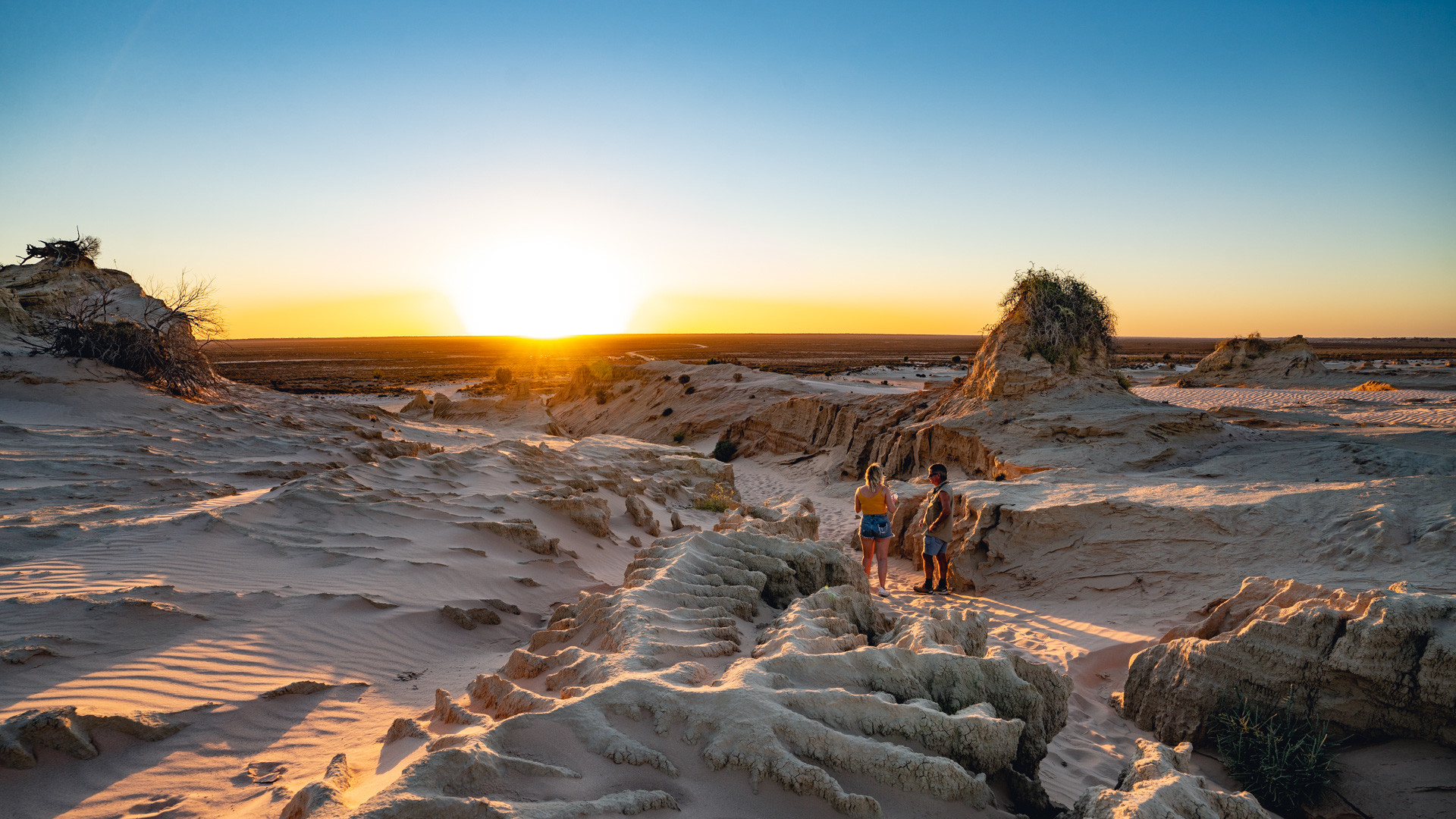
We skid to a halt. The unsealed road is badly corrugated following heavy rains and parts are completely washed away. A gaggle of sheep skitter onto the road, stop, then panic and run back.
Cattle have ambled across the track but we’re most worried about kangaroos bounding out. There’s a lot of roadkill.
We’re headed to Mungo National Park, or Lake Mungo – but there’s no lake – in the plains of south-west NSW. It’s only about 140 kilometres from Mildura, on the Murray River at the Victorian border.
Yet, not far from town, it starts to feel remote. The landscape is wide and low to the horizon, reddish dirt with tussocky grass, scrubby salt-bush and occasional stands of stunted trees.
From inside the car this countryside doesn’t look much, but when you stop on the side of the road and get out you can hear that whispery country silence. Branches crackle underfoot, there’s the scent of the bush and eucalyptus hanging in the air.
Mungo is part of the Willandra Lakes Region, which sprawls across 2400 square kilometres of semi-arid countryside. This was part of a chain of freshwater lakes that dried up about 18,000 years ago but preserved within the desolate landscape are signs of megafauna, calcified tree roots tens of thousands of years old, and rich cultural heritage.
Trees and shrubs held the sand and soil together until the coming of European settlers and livestock.
Vegetation was cleared for wheat growing, trees were cut for houses and woolsheds. When the farmers ran out of money, they cut down the native white cypress “because the termites don’t like it” says our guide, and sold it for building material.
Ancient middens – shells, bone and other signs that Indigenous people had hunted and gathered here millennia ago – were discovered, and Mungo was added to the World Heritage list in 1981, along with the Great Barrier Reef and Kakadu.
Then in 1968 the cremated skeleton of Mungo Lady was found and in 1974 the ochre-stained bones of Mungo Man were revealed. Both were over 40,000 years old. These are some of the oldest remains of humans ever found. They’re important for all humanity but also point to the ancient heritage of Australia’s Indigenous people.
Visitor centre and Mungo woolshed
At the visitor centre we get our bearings and learn a little about the region’s natural, Indigenous and pastoral history. There’s some fascinating information here and also online at Visit Mungo, including a guidebook you can download.
Just across from the centre stands the 1869 Gol Gol Station shearing shed. The heavy timbers are soaked in lanolin from the literally millions of sheep that passed through here over almost a century.
The shed was a social hub too – photos in the visitors centre show bush parties and get-togethers that were held in the shearing shed over the decades.
Tour to the Walls of China
We join a tour with a park ranger, so we have access to the Mungo lunette or Walls of China (“the Chinese labourers who worked here called it that”) and beyond the boardwalk onto the sand, which is off-limits otherwise.
Three traditional tribal groups share the custodianship of Mungo NP. This is their land, their culture, their story. The rangers who manage and share the knowledge of the park are also from these tribes: Paakantji/Barkindji, Ngiyampaa and Mutthi Mutthi. They walk in the footsteps of their ancestors – quite literally.
In 2003, the shifting sands revealed footprints that are more than 20,000 years old. Hundreds of prints criss-crossed the claypans, showing groups of hunters, family groups with women and young children, captured forever. The original prints were copied and covered again to preserve them, but there are casts at the centre.
We drive for about 10 minutes in a dusty convoy towards the crescent-shaped lunette, then follow a boardwalk before stepping onto the sand and the Moon-like surface of pinnacles and ridges, peaks and gullies.
Our guide shows us darkened sand where middens are located.
“These represent ‘old fireplaces’ where Aboriginal people would cook their freshwater mussels and other foods.”
As the sand blows away, other bones and tools are exposed.
“That sand is moving all the time – headed for Canberra,” our guide deadpans.
It’s difficult to imagine that water once covered this entire area. The more we look, the more we see. We also spot fresh kangaroo prints, emu prints and small marsupial footprints.
As the sun begins to set, we settle ourselves on various outcrops, looking west as the sands change colour, gradually glowing orange, drawing long eerie shadows across the Moon-like landscape. A line of purple edges the horizon. The light dies and the stars slowly come out, shining on this ancient land. It’s at once serene and surreal.
Other tours
For those staying longer, there’s a self-guided driving tour of 70 kilometres that loops around the park through Mallee country, and takes about two hours. Stop for the Red Top lookout and boardwalk for a sweeping view of the heavily eroded landscape.
There’s also the 350-kilometre Zanci Pastoral Loop, suitable for a mountain bike ride. It follows the old fenceline that was once the boundary between Zanci and Gol Gol stations. There are other walking and four-wheel-drive tag tours, run by Parks and private operators such as Mungo Guided Tours .
Where to stay
There’s a campground (caravan, trailer and tent sites); fees are payable.
Mungo Shearers Quarters next to the visitor centre are basic but clean with cooking facilities (bring your own bedding and food).
For those seeking a little more comfort, try Mungo Lodge, which has cabins and glamping, as well as a bar and bistro (the only restaurant in the park).
Staying safe
If you’re driving yourself, it’s best to stay at least one night to avoid driving at dusk or at night. Roads are mainly unsealed and wildlife wanders out. The roads can be closed due to bad weather or fires.
Take extra food, fuel and spare tyres. Mobile reception is limited, so download maps, including the Mungo NP park map, before you go.
It can get extremely cold in winter, extremely hot (up to 50 degrees) in summer, so be prepared.
The author travelled courtesy of Murray River Tourism
